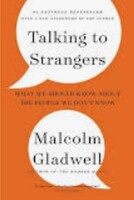Book notes: Talking to Strangers
May 10, 2024
By Malcolm Gladwell.
Got this book as a Christmas gift. On Amazon it has 4.5 stars on >23k ratings.
Scoring:
- Axe for the frozen sea: 10/10.
- Page count: 355. Effective page count in the low 200s.
How good are we at reading and understanding a stranger? If they share our culture and wear their intentions transparently on their facial expressions and body language, then we’re pretty good at it. Otherwise not. “Strangers are not easy.” (p50) We “default to truth” and it takes a certain amount of evidence to make us realize we are being lied to.
Society works much better though if we’re occasionally tricked by some good liars rather than being overly-paranoid all the time.
The author’s motivations for the book came about while trying to understand what went wrong during some fatal police interactions. Specifically the Death of Sandra Bland.
Transparency in emotions. In an episode of Friends, everyone’s emotions were acted out perfectly with what we expect. But sometimes innocent people act guilty, e.g. Amanda Knox wrongfully incarcerated for 4 years for a 2007 murder in Italy. Sometimes guilty people act innocent: e.g. Bernie Madoff. Sometimes we don’t show our true emotions on our face.
Many cultures don’t interpret facial emotions the same way. E.g. people on the Trobriand islands couldn’t tell the difference in emotion from 6 different emotion pictures (sad, happy, angry, etc) from western culture.
Coupling: A behavior can be “coupled” with a location… E.g. crime in neighborhoods. Most of a “bad” neighborhood is quite safe, a majority of the crime happens in a specific place like an address or intersection/block. Suicides are “coupled” with a type of suicide (pills, “town gas” in England in the 60s), and even specific bridges. Putting a fence on the Golden Gate bridge reduced suicide deaths (me: same with Aurora bridge in Seattle). You would think folks would find another way to die, but counterintuitively that’s not what happens. Banning handguns would conservatively save 10k lives/year in the USA in prevented suicides (p276).
Kansas City Police Experiments: Early 1990s, Kansas City police ran an experiment that worked. The premise was to take guns out of high crime areas. Police would pull over any car for any small reason and search it… assume most cars have guns. Deaths plummeted quickly. Only do this in isolated high crime areas, in most places the citizenry won’t accept this aggressive policing, and it won’t produce results. This was the mistake in the Sandra Brown case.
We demand that our police be superheros to do a good job, but that’s unrealistic. “Let us make it our goal, then, to simplify the responsibilities of the police.” (p354)
This book was insightful and entertaining at the same time, though some of the subject matter is intense.